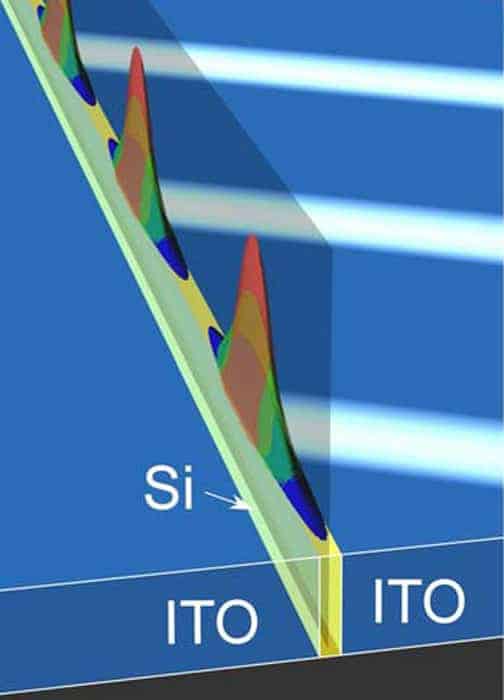
A simple, solid-state waveguide that can “stop” light has been proposed by physicists in the UK. The researchers say that their device – which has yet to be built in the lab – would be straightforward to create and could be used as an interface between electronic and optical circuits. The waveguide could also lead to the development of new lasers and molecular-imaging systems.
Unlike the phase velocity of light, which is the speed at which individual wavefronts move, photons travel at the group velocity of light waves. This is the speed at which each wavepacket advances as the individual wavefronts pass through it. If you want to hold a pulse of light still, therefore, you need to reduce this group velocity to zero. In principle, this can be achieved in photonic crystals, which are synthetic materials comprising periodic regions of high and low refractive index. However, unavoidable inhomogeneities in these structures have prevented light from being completely stopped in these materials.
An ingenious alternative is electromagnetically induced transparency, in which two laser beams suppress an electronic transition excited by light at a certain frequency, making the material transparent to that particular light. If one of the lasers is suddenly turned off, light can be trapped inside the material and stored for up to a minute within coherent spin excitations of the material’s electrons, before being released when the laser is turned back on. However, this must be done at temperatures near to absolute zero in order to preserve the coherence of the spin excitations. Furthermore, it does not truly store photons, instead preserving the information of the photons in another form.
Complex frequencies
Now, Ortwin Hess and colleagues at Imperial College in London have unveiled a simpler scheme. They calculate that a 290-nm-thick silicon slab clad in 500 nm layers of indium tin oxide (ITO) would support optical modes with frequencies that are complex numbers. Furthermore, one of these modes would have a group velocity of exactly zero.
A practical question is how these modes could be excited, given that one cannot send light down a waveguide at zero velocity. The Imperial team argues that the solution lies in the fact that the zero-velocity mode is a leaky mode, which means that light in the silicon waveguide can escape through the ITO cladding as a type of non-propagating wave called an evanescent wave. This would be a disadvantage in an ordinary waveguide, but the researchers have now turned it to their advantage.
“In the same way that you can radiate out, you can also use that trick to radiate in,” explains Hess. The team calculates that near-infrared light shone on the waveguide at a specific angle would excite an evanescent wave in the ITO. This would then excite the desired zero-velocity mode in the silicon slab. Intriguingly, the wavepacket in the slab has almost no dispersion, which means that not only would it not move forwards, but the different wavelengths would also not spread out. This could be useful for boosting the number of optical data that could be transmitted down a waveguide.
Going to California
The researchers calculate that the effect should survive realistic levels of imperfection in the surfaces of the ITO and silicon, and experimentalists in California are planning to realize the set-up. If successful, Hess believes that the work could lead to several applications. The group is currently working on a tiny “stopped-light laser”, in which a stationary pulse of light can be pumped and amplified with no need for a cavity or mirrors. Beyond this, holding light in one place would massively increase the probability of it interacting with matter. This could have applications in optical computing, high-efficiency solar cells and even biomolecular imaging. It might also be useful for creating an optical quantum memory.
Nicholas Fang of the Massachusetts Institute of Technology applauds the work. “This is a unique approach to squeeze light into deep sub-wavelength features,” he says. “This is probably the smallest optical fibre that one can engineer right now.” He is particularly impressed by the fact that the design does not need any exotic materials. “The core is a standard silicon material and the waveguide traps light using a conducting oxide that is very often used in the display business, so both materials are fairly familiar to the photonics industry.”
The research has been accepted for publication in Physical Review Letters.


